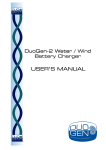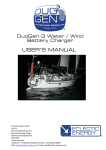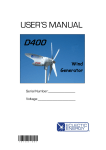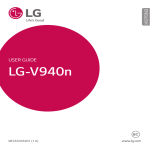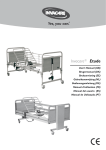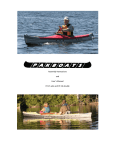Download DuoGen User`s Manual
Transcript
DuoGen Water / Wind Battery Charger USER’S MANUAL The Physics of Wind Generation It is important to bear in mind that the output you can expect from a wind generator is directly related to the speed of the wind and to the area of wind your generator can intercept. If there is not enough wind, even if the turbine is turning, your generator will not produce any power. And a turbine suitable to mount on a yacht is naturally limited in size. However, as the wind speed increases, output increases exponentially. The reason is that wind generator output is proportional to the cube of the wind speed. Wind, as all sailors know, is a highly variable power source, and in addition cruisers tend to sail downwind and tie up or anchor in sheltered positions which reduces wind speeds further. Using a wind generator will help to maintain the batteries between engine charging, shore power etc. but is unlikely to replace medium to high daily electricity use. This is why DuoGen has the answer. By deploying the water mode when you go cruising, you tap into the wind power that the yacht’s sails intercept, which is many times greater than that of a yachtsized turbine. This is where DuoGen’s great output comes from, much more powerful and efficient than running a wind generator at sea, and much easier to live with. Welcome to DuoGen Congratulations on your purchase of the DuoGen water/wind battery charging system for yachts. CONTENTS The physics of Wind Generation DuoGen has been especially designed and precision manufactured to provide the most practical and user-friendly system currently available for renewable energy electricity generation on cruising yachts. DuoGen is a combined water and wind generator that can be easily reconfigured to harness the kinetic energy in either a wind stream or a water stream in order to produce electricity. DuoGen has been specifically designed for use aboard cruising yachts where the wind mode is operated in harbour or at anchor, and the water mode is deployed when the yacht is under way or at anchor in flowing water. The benefit of this dual mode system is that the owner has greater potential for energy conversion than is possible with a single source system. This is because the air stream intercepted by a yacht’s sails when it is under way is many times the area intercepted by a typical wind turbine. In a given wind speed, therefore, the amount of battery charging power produced is usually far greater when a yacht is under sail and a water generator is deployed. DuoGen brings the benefits of dual mode operation to the yacht owner in a truly practical form. The change from water to wind mode is accomplished in seconds without the use of tools and without having to demount and reposition major system elements or electrical connections. This instruction manual contains important safety information which will enable you to get the most from your DuoGen. Please read this manual thoroughly prior to the installation and operation of the equipment. When using your DuoGen, always exercise due care and operate the equipment in accordance with the manufacturer’s recommendations contained in this manual. DuoGen should then deliver years of trouble free service. 1 Welcome to DuoGen 1 Mounting options 2 Installing DuoGen 2 DuoGen in wind mode 3 Wind mode outputs 3 DuoGen in water mode 4 Water mode outputs 4 Adjusting the diving plane 4 Drag 4 Drag performance comparison 4 Electrical Connection (with circuit diagrams) 5/6 Using a battery monitor 5 Deploying DuoGen in wind mode 7/8/9 Self-furling 10 Deploying DuoGen in water mode 11/12/13 Maintenance and repairs 14 Spare parts list 14 Contact details 14 Regulation 15 Commissioning 16 System Monitoring 16 Performance and Expectations 17 Guarantee 18 Certificate of conformity 18 Your notes 18 Installing DuoGen DuoGen is supplied complete and ready to install. There may, however, be ancillary items you will need to incorporate in order to optimise the installation. Duogen is normally mounted to the pushpit rails in aft cockpit boats. For yachts where no suitable support structure exists, additional bracketry, such as the Universal Bracket, would be required. Alternatively the lower bracket can be bolted through the coaming or transom and some form of bracing devised to support the top bracket. Mounting DuoGen on yachts with extreme retrousse sterns and/or large bathing platforms is usually possible, but additional bracketry may be required. DuoGen should be placed either on or as close to the yacht’s centre line as possible. This minimises the effects of heeling on the running depth of the water mode. However, in practice, if the mounting is within 800mm of the yacht’s centre line DuoGen will perform well. Once DuoGen has been installed all subsequent operations and mode changes are accomplished without the need for tools. There should be a minimum distance of 400mm between top and lower brackets for the short tower and 650mm for the long tower to ensure that the machine is adequately braced against wind loadings. See dimensioned mounting schematic provided with the installation instructions. Now is the time to order: extension cable waterproof gland regulator charge splitter etc. Mounting Options See Parts list on Page 13 2 DuoGen in Wind Mode Wind Turbine Air blade Transmission (NB. this unit now features sealed roller bearings and helical mitre gears.) Air hub Turbine securing pin Drive shaft securing pin Drive shaft Recovery lanyard shackle Yaw arm Yaw arm release plunger Tower Top bracket Pushpit clamps This part has been replaced with a thumbscrew. Clamp shaft Tower clamp Alternator mount pins ‘C’ bracket Alternator Alternator yoke 3 DuoGen has been carefully designed to be as safe as possible in operation. However, all rotating machinery is potentially hazardous, and in consequence, the equipment should be operated in accordance with the manufacturer's instructions at all times. DuoGen in Water Mode Adjusting the diving plane The angle of attack of DuoGen’s diving plane is adjustable by -2º to +4º either side of 0º or hydrodynamic neutral. The neutral point is found by aligning the mark on the diving plane and water impeller bracket. 0º should prove suitable in most cases. Adjusting the diving plane in the minus direction will cause the impeller to run nearer the surface and adjusting in the positive direction will cause it to run deeper. Ensure that the bolt and lock nut are tightened firmly. Don’t forget - you can dismantle and store the parts of DuoGen you are not currently using. DuoGen's water mode is generally benign in operation, but care should be taken when deploying the unit that no swimmers or other obstructions are in the water beneath it. Yaw arm lock hole Water bracket Water impeller and transmission Drag: DuoGen’s water mode operates in the top 1/2 metre of water, within the same wave as the yacht. Amp for amp,drag from the impeller unit is 30 % lower than that of other towed units. Diving plane 4 Electrical Connection Connect the output cable to the battery bank(s) using the suggested wiring diagrams for guidance. Remember to observe the correct polarity. RED to POSITIVE + and BLACK to NEGATIVE – Where a battery monitor is fitted If your yacht is fitted with a digital battery monitor, a shunt will have been installed close to the batteries. One side of the shunt is connected directly to the battery terminal or busbar. All other connections are made to the opposite side of the shunt. The shunt is most usually connected in the negative line. When wiring DuoGen to a system fitted with a shunt, observe polarity and connect the appropriate DuoGen output cable to the non-battery side of the shunt. Again observing polarity, the other DuoGen output cable should be made directly to the battery terminal or busbar. DuoGen’s output will now pass through the shunt and the monitor will display a reading. If the shunt is bypassed by connecting both positive and negative output leads to the battery, the meter will fail to ‘see’ DuoGen, and register no output. DuoGen is fitted with 4.5 sq. mm. cable. Use cable of at least this cross -section. An in-line fuse rated at 35 amps is supplied. It is important that a fuse is fitted close to each battery bank. 5 Electrical Connection It is recommended that DuoGen be permanently wired through a deck gland and that the cable enters the yacht via a cable gland. Deck plugs and sockets should not be used. DuoGen must always be connected to a battery when in use, otherwise a dangerously high voltage can be generated at the output cable. If in doubt, refer to a competent electrical engineer or the manufacturers. 6 Deploying DuoGen in Wind Mode To assemble the wind turbine, we recommend that you kneel and work on a firm surface, such as the cockpit floor. This not only makes the operation easy, but also makes it very unlikely you will drop any components overboard! Slide the key on one blade root into the keyway on the next blade. Continue in this way until you have assembled four blades. With the assembly resting on the floor with the gap uppermost, position and slide the last blade into place. Care should be taken when dismantling and re-assembling the air turbine rotor, as, for maximum aerodynamic efficiency, the blades feature fine trailing edges which can cause injury if not handled with caution. The air hub features concentrically arranged conical pins. Identify the matching conical recess in the turbine blade assembly and offer the turbine hub up to that side, aligning the pins with the recesses. Finally, to complete the assembly, screw the clamping plate onto the hub and tighten firmly. Spring pawls are fitted in the clamp plate to prevent vibration from loosening it, and you will hear these clicking as you tighten the clamp plate. Use only firm hand pressure to tighten the clamp plate. Finally, visually check that both hub and clamp plate are firmly seated on the blade roots. There should be no gaps or movement evident in the completed assembly. Check that the top tower bracket strap is securely closed and that the locking pin is in place (see box left). Check that the alternator yoke is locked centrally by tightening the thumbscrew.Orientate the yaw arm so that you will be fitting the turbine downwind, and ensure that it remains downwind throughout the operation. 7 The top tower bracket braces the machine in a vertical position when operating in wind mode, and features a two stage locking mechanism on the main tower clamp in order to prevent accidental release when the machine is running. It is essential to ensure that this clamp is secure. It should close with an audible ‘snap’ and the clamp should fit the tower firmly. Hold the clamp at both sides and press the strap closed. Next, fit the locking pin, ensuring that the lanyard has passed around the tower as an additional failsafe before operating in wind mode. NB. - if the hinged clamp strap will not ‘snap’ home with reasonable pressure, ensure that the top tower bracket is correctly aligned and square to the tower tube. Wind mode (continued) Gripping the transmission element in one hand and holding a blade with the other to prevent rotation, offer the air tenon up to the yaw arm socket. WARNING Never be tempted to hold the turbine by hand in the wind and let it run. This is highly dangerous. The turbine will accelerate very rapidly, and the forces generated will become difficult to control, due to the effects of gyroscopic progression. Align the holes in the yaw arm and the air tenon, and insert the turbine securing pin and lock with a beta pin. Once the tenon is located in the socket, tie a short piece of line around the blades and the yaw arm to prevent blade rotation. Extend the drive shaft until the connector boss mates with the turbine transmission. Rotate the drive shaft until the holes align and insert the drop nose pin. Note that there is an etched mark on the connector boss which aids alignment. Rotate the drop nose tab through 90° and push backwards so that it forms a ‘T’ - this is the lock position as the tab is retained by a ball spring. 8 Wind Mode (continued) Holding an air blade to prevent rotation, remove the lashing on the blades. Raise the yaw arm to the top of the tower and release the spring plunger. Note that in wind mode the plunger rests on the top tower bearing rather than being located in the yaw arm lock hole. In wind mode, as with all wind turbines, the major hazard lies in accidental contact with the turbine blades. Although DuoGen's blades run more slowly than many competitor machines, they are still capable of inflicting injury. When correctly installed and operating, DuoGen's air blades are safely above head height. By using the handle on the machine's yaw arm, DuoGen can quickly be stopped even in severe conditions, without any risk of injury from the blades. Finally, release the air blade and, using the yaw arm handle, turn the turbine into the wind The turbine will begin to run. To stop DuoGen wind mode, grasp the yaw arm handle and turn the machine gently through 180º. The turbine will slow down and stop. As soon as it stops, grip a turbine blade to prevent rotation (the blades will run backwards down wind!). Release the spring plunger and lower the yaw arm to stop. Secure the blades with a lashing of light line. 9 NOTE: DuoGen should always be stopped using the yaw arm handle, even where an electrical brake switch is fitted. Furling in Wind mode DuoGen’s wind mode incorporates self-furling. As the wind speed increases, the air rotor turns about the main tower, presenting a progressively reduced intercept area to the wind. High electrical outputs are maintained, but the wind loading on DuoGen, its mounting and ultimately the yacht’s moorings, are controlled. In moderate breezes, the rotor may sit 5º to 10º off the wind, and in high winds 20º to 30º. In practise, DuoGen will furl gently as a heavy gust strikes and then return to its original position as the gust passes. It is analogous to the yacht heeling to a heavy gust of wind. The furling force is provided by the alternator’s reluctance to be accelerated. This furling force is balanced by the wind loading on the air turbine disc, and DuoGen’s tail. In certain conditions, excessive or erratic furling may be observed. Probable causes are: a) the operation of the regulator - as the regulator starts to dump power, the alternator suddenly becomes ‘stiffer’ to turn and this produces a large increase in the furling force. b) turbulent air - as the furling force is balanced primarily by the wind loading on the rotor disc, turbulence and sudden ‘holes’ in the wind can result in an excessive and erratic furling action. Such turbulence is usually caused by obstructions upwind or down wind of the turbine, and are particular to a certain location and wind direction. c) mechanical or electrical fault - usually indicated by low or no electrical output, and/or undue mechanical friction and noise. 10 Deploying DuoGen in Water Mode Release the yaw arm spring plunger and lower the yaw arm to stop. Insert the water bracket tenon into the rear of the mounting socket on the yaw arm. DuoGen's water mode pivots in two planes at the alternator mounting to allow for manoeuvring the yacht and for wave action. In common with other water generators, this hinging creates a potential trap hazard for hands and fingers. DuoGen is designed with generous clearances to minimise the risk of accidental crush injuries. Nevertheless, handling the alternator and its mounting yoke when the water mode is deployed should be avoided. Secure with a pin and a beta clip. Extend the drive shaft until the connector boss mates with the impeller transmission. Rotate the drive shaft until holes align and insert the drop nose pin. Attach the recovery lanyard to the shackle on the yaw arm. Form a loop on the inboard end and drop it over the hook on the upper tower clamp. Adjust the length of the lanyard such that it holds DuoGen clear of any part of the yacht’s structure (ie. steering system servo oars) when the yacht is stationary. The lanyard should hang loose when the yacht is underway and DuoGen is operating normally. 11 DON’T PUT YOUR HANDS HERE! Water Mode WARNING: DuoGen should never be allowed to operate if it is not connected to a battery. This condition allows the machine to overspeed and very high voltages can be produced. Running in Water Mode DuoGen’s alternator yoke allows freedom of movement in two planes so that wave and helm action can be accommodated. Although you can motor slowly astern with DuoGen deployed,we would recommend that the equipment is deployed once the yacht is moving slow ahead. The yaw arm is raised and the spring plunger located in the yaw arm lock hole. Remove the upper tower clamp locking pin and unclip the retaining strap. Holding the recovery lanyard, push DuoGen backwards freeing the tower from the tower clamp. The unit can now be gently lowered into the water using the recovery lanyard. Due to its closed cell foam filling the yaw arm is naturally buoyant. However, if the yacht is stationary and a sea is running, the relative movement of the yacht and DuoGen can cause the tower to bump against the transom of yachts with retrousse sterns. To avoid this, tie a loop in the recovery lanyard and drop it over the hook incorporated in the upper tower clamp assembly. Adjust the length of the line such that it becomes taut just before DuoGen’s tower contacts the yacht’s transom. On yachts with a near vertical or counter transom, the recovery lanyard should be adjusted such that DuoGen cannot pivot downwards beyond an angle of 60º from the water surface. (The normal running angle of the machine is less than 40º). This ensures that if the yacht is stationary and rolling heavily, the side forces imparted to the machine are dissipated by the ‘c’ bracket pivot. If DuoGen is allowed to fall to the vertical, the ‘c’ bracket pivot can no longer relieve the side forces and in some cases, deformation of the alternator yoke may result. In normal operation when the yacht is underway, the recovery line will hang loose, as DuoGen rides on its diving plane Having deployed DuoGen water mode, release the alternator yoke by unscrewing the black thumbscrew on the ‘c’ bracket. This allows the alternator yoke to pivot laterally. To prevent accidental contact with other stern mounted appendages such as transom hung rudders and self steering, DuoGen’s ‘C’ bracket incorporates additional holes to take limit pins (supplied as spare parts if required). Once fitted, these pins restrict DuoGen’s lateral movement to 15º either side of the yacht’s axis. A clearing line can be utilised if clogging of the impeller is a problem. This is best accomplished with the piece of 3mm prestretched line supplied, secured by a stopper knot through the hole in the diving plane, and the other end made fast around the yaw arm. The bitter end of the line is passed through the lower hole in the tail. Two additional holes are provided at the tips of the diving plane and further lines can be passed through these and secured in a similar manner to provide even more protection against floating debris. 12 Water Mode (continued) Recovering DuoGen from Water Mode To recover DuoGen from water mode with the yacht stopped or moving slow ahead, centralise the alternator yoke and tighten the ‘C’ bracket thumbscrew. This will lock the yoke in its central position. Using the recovery lanyard, pull DuoGen out of the water and back to the vertical. Clip the tower into the tower clamp and re-secure the clamps retaining strap. Complete this operation by fitting the failsafe locking pin, looping the lanyard around the tower for extra security. Pull the yaw arm lever to release the spring plunger from the yaw arm lock hole, and lower the yaw arm to its stop. Always ensure that electrical connections are secure and permanent. Always fit an in-line fuse (35A). Do not use crocodile clips. Use a waterproof gland where the cable passes into the boat. Use extension cable which is at least the same cross-sectional area as the cable supplied by DuoGen, that is 4.5² mm. Corroded connections are the single biggest cause of electrical failures on yachts. It is good practice to smear battery terminals and other exposed connections with petroleum jelly in order to prevent this. Once DuoGen is installed, it is not necessary to disconnect the electrical connections when changing mode. Withdraw the drop nose pin and disconnect the drive shaft. Withdraw the turbine securing pin and remove the water turbine assembly from the yaw arm. Ensure that the cable runs freely and without obstructions. Should DuoGen be vibrating or unduly noisy in operation, it should be stopped immediately whilst the cause is identified. DuoGen should never be allowed to run with damaged, cracked or misaligned turbine or impeller blades. 13 Repairs and Maintenance SPARE PARTS We recommend that you carry the following parts in case of loss or damage: 1 x drop nose pin 2 x air turbine blades 1 x turbine securing pin and beta clip (tower pin set) 2 x 35 amp fuses (12 V) 2 x 20 amp fuses (24 V) 1 x tower lock pin ‘c’-bracket locking pin set airdrive grease set of water drive bearings flexible drive shaft coupler CONTACT DETAILS For after sales service and information, spare parts and repairs, contact DuoGen is designed to require minimal maintenance, but a little attention will pay dividends in terms of appearance and performance. Periodic washing with fresh water will remove accumulated salt deposits and keep the yaw bearings and the telescopic drive shaft sliding smoothly. An occasional application of a domestic siliconebased polish on the tower tube and drive shaft is also recommended. The alternator requires no maintenance as it is hermetically sealed, and the bearings are protected by a twin lip radial shaft seal. The water mode is robust and efficient, and maintenance free as the impeller transmission device is lubricated by a combination of synthetic graphite within the matrix of the bearing material and water. When dry following immersion in sea water, the unit may feel a little stiff. This is due to dry salt deposits and the unit should free up immediately it is returned to the water. However, this unit rotates about 5 million times for every thousand miles sailed, and like all mechanical devices, is prone to wear. We recommend that the transmission elements are replaced every 3 - 4,000 nautical miles, or 15 - 20 million revolutions, in order to maintain optimum performance. This is a straightforward procedure that can be undertaken by the owner. DuoGen’s air mode transmission device has now been upgraded and incorporates sealed roller bearings and helical mitre gears. These gears benefit from an occasional light application of a good quality weather resistant grease, as supplied. Sales Department Eclectic Energy Limited Edwinstowe House High Street Edwinstowe Nottinghamshire United Kingdom NG21 9PR phone: +44 (0)1623 827829 fax: +44 (0)1623 821540 e-mail: [email protected] 14 Regulation DuoGen is capable of delivering sustained levels of high power. Therefore it is important to ensure that overcharging does not occur. Overcharging is characterised by excessive battery terminal voltages and loss of electrolyte. Permanent battery damage can result. The two main strategies to avoid this are: Manual Monitoring This entails monitoring battery state and simply starting or stopping DuoGen as required, For owners who live aboard this is a viable option, particularly if the battery bank is of high capacity. Dump Regulation Eclectic Energy Limited can supply a dump regulator which is installed close to the batteries. The regulator is adjustable between 11.5 and 17V. You set the voltage in accordance with the battery manufacturer's recommendations and as this voltage is reached, the regulator progressively diverts DuoGen’s output to a pair of large wire wound resisters where the excess power is lost as heat. The Pros and Cons of Regulation Eclectic generally recommends that DuoGen is used in conjunction with a regulator. However it is important to be aware of their limitations. As they work by sensing battery terminal voltage, anything that raises that voltage, such as a solar panel, can cause the regulator to dump power prematurely. A good compromise, which we recommend, is to fit a regulator, but install a bypass switch. On passage when you can monitor the system, bypass the regulator. When you leave the boat, switch it back on. Note that where a bypass switch is fitted, the charge splitting function of the regulator is also bypassed when the switch is activated. We recommend that the bypassed output is fed to the largest bank (usually the serviced batteries). Alternatively, a dedicated charge splitter can be installed to distribute the unregulated output across two banks. 15 Commissioning With installation steps complete, you should be ready to operate DuoGen for the first time. Before starting the machine it is advisable to take a moment and: - check that all fasteners on the mounting brackets have been fully tightened - check that the electrical connections are secure and well made, and that the cable exiting the alternator does not snag or pull as the DuoGen moves from one mode to another - check that the line fuse has been replaced in the fuseholder With the yaw arm in its raised position and the airblades fitted (tied off with a piece of line to prevent rotation), turn the arm through 360º to ensure there is no possibility of contact between the blade tips and other equipment mounted on the yacht. System Monitoring It is notoriously difficult to monitor wind turbine performance in real world conditions because the wind is dynamic, continually fluctuating in both direction and strength. The most accurate performance assessment can be obtained with a hand-held anenometer at turbine hub height, and a digital ameter connected in line between DuoGen and the regulator. However, given due consideration of the points made earlier, the ship’s anenometer and battery monitor are perfectly adequate to ensure that your system is working well. Refer to the section on page 5 (Electrical Connection) to ensure the ship’s battery monitor can ‘see’ DuoGen. If you are still unsure that the system is working as it should, do not hesitate to contact us and we will do all we can to resolve the problem. 16 Performance and Expectations Unless there is a fault either with the machine or the installation, DuoGen should perform broadly in line with the published output graphs. If the outputs initially seem lower than expected, consider the following variables: - the energy in the wind stream varies as the cube of the wind speed. As a result, even small changes in windspeed have a profound effect on the amount of power a wind turbine can produce. For example, there is 73% more power available in a 12 mph breeze than at 10 mph. - the commissioning of the wind mode is likely to be taking place in a marina or harbour. These locations are usually chosen specifically because they are naturally sheltered places. - if you are reading windspeed from a masthead anenometer, it is likely to be operating in much clearer, faster air than the turbine and it is not unusual to have a windspeed differential of 5 or 6 mph from the masthead to the turbine. - also, in harbours and marinas the wind at DuoGen’s hub height is often very turbulent, due to obstructions upwind of the turbine. Turbulent air dramatically reduces the efficiency of the turbine, in the same way as turbulent air slows a yacht in match racing. - if a regulator has been fitted as part of the installation, and charge reaching the batteries seems low, it is probable that the batteries are fully charged and the regulator is doing its job and ‘dumping’ the excess power. This dumped power will not be registered by the yacht’s battery monitor. If you suspect this to be the case, switch on some electrical loads. This will lower the batteries’ terminal voltage and should cause the regulator to progressively dump less of DuoGen’s output, sending more of it to the batteries which the monitor will register. 17 Your Notes www.eclectic-energy.co.uk DECLARATION OF CONFORMITY We declare that this product complies with the following standards/directives: 89/336/EEC Product description: 'DuoGen' Alternator Model number: EE100 Serial number: Signed:__________________________________ Dated:________ Managing Director Eclectic Energy Limited Edwinstowe House High Street Edwinstowe Nottinghamshire United Kingdom NG21 9PR +44 (0) 1623 821535 GUARANTEE DuoGen is guaranteed against faulty parts and manufacture for a period of twelve months from date of purchase. The unit should be returned prepaid to: Eclectic Energy Ltd Edwinstowe House High Street Edwinstowe Nottinghamshire United Kingdom NG21 9PR Damage caused by mishandling, faulty installation or accident is not covered. Eclectic Energy can not be liable for damage caused by DuoGen in the event of accidental contact, incorrect installation or insufficient care. However, Eclectic Energy Limited is committed to provide after sales care as fully and efficiently as possible in order to support our customers. This guarantee does not affect your statutory rights. 18 DuoGen is manufactured in the UK by Eclectic Energy Limited Edwinstowe House High Street Edwinstowe Nottinghamshire NG21 9PR United Kingdom Phone: +44 (0) 1623 821535 www.duogen.co.uk





















